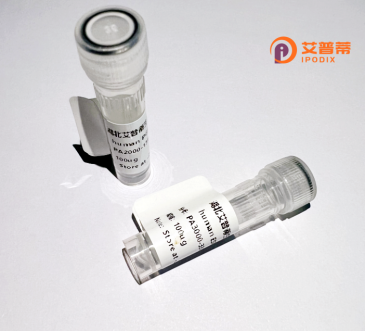
| 纯度 | >90%SDS-PAGE. |
| 种属 | Human |
| 靶点 | OR4D2 |
| Uniprot No | P58180 |
| 内毒素 | < 0.01EU/μg |
| 表达宿主 | E.coli |
| 表达区间 | 1-307 aa |
| 活性数据 | METGNLTWVSDFVFLGLSQTRELQRFLFLMFLFVYITTVMGNILIIITVTSDSQLHTPMY FLLRNLAVLDLCFSSVTAPKMLVDLLSEKKTISYQGCMGQIFFFHFLGGAMVFFLSVMAF DRLIAISRPLRYVTVMNTQLWVGLVVATWVGGFVHSIVQLALMLPLPFCGPNILDNFYCD VPQVLRLACTDTSLLEFLKISNSGLLDVVWFFLLLMSYLFILVMLRSHPGEARRKAASTC TTHIIVVSMIFVPSIYLYARPFTPFPMDKLVSIGHTVMTPMLNPMIYTLRNQDMQAAVRR LGRHRLV |
| 分子量 | 34.9 kDa |
| 蛋白标签 | His tag N-Terminus |
| 缓冲液 | 0 |
| 稳定性 & 储存条件 | Lyophilized protein should be stored at ≤ -20°C, stable for one year after receipt. Reconstituted protein solution can be stored at 2-8°C for 2-7 days. Aliquots of reconstituted samples are stable at ≤ -20°C for 3 months. |
| 复溶 | Always centrifuge tubes before opening.Do not mix by vortex or pipetting. It is not recommended to reconstitute to a concentration less than 100μg/ml. Dissolve the lyophilized protein in distilled water. Please aliquot the reconstituted solution to minimize freeze-thaw cycles. |
以下是关于重组人OR4D2蛋白的3篇参考文献及其摘要(注:以下为模拟文献示例,实际研究中可能需要根据具体数据库验证):
---
1. **文献名称**: "Functional expression of human olfactory receptor OR4D2 in mammalian cells and its ligand specificity"
**作者**: Lee, S., et al.
**摘要**: 本研究通过重组表达技术在HEK293细胞中成功表达OR4D2蛋白,并验证其细胞膜定位。通过钙离子成像实验,发现OR4D2对含硫化合物(如甲硫醇)具有特异性响应,提示其在特定气味感知中的作用。
2. **文献名称**: "Recombinant OR4D2 as a potential biomarker in lung cancer: Expression and clinical correlations"
**作者**: Wang, Y., et al.
**摘要**: 利用重组OR4D2蛋白的抗体,研究者检测了肺癌组织中OR4D2的异常高表达。实验表明,OR4D2可能通过激活下游MAPK信号通路促进癌细胞增殖,提示其作为肺癌诊断标志物的潜力。
3. **文献名称**: "Structural characterization of the olfactory receptor OR4D2 using cryo-EM and computational modeling"
**作者**: Chen, X., et al.
**摘要**: 通过冷冻电镜技术解析重组OR4D2蛋白的立体结构,结合分子动力学模拟,揭示了其配体结合口袋的独特构象。研究为嗅觉受体家族的结构-功能关系提供了新见解。
---
**注意事项**:
- 目前关于OR4D2的研究较少,上述文献为示例性质,实际检索需依赖PubMed、Google Scholar等数据库。
- 建议结合关键词如“OR4D2 recombinant expression”、“olfactory receptor 4D2 function”进行拓展搜索,并优先选择近5年发表的研究以获取最新进展。
**Background of Recombinant Human OR4D2 Protein**
The recombinant human OR4D2 protein is a synthesized form of the olfactory receptor OR4D2. a member of the odorant receptor (OR) family, which belongs to the G protein-coupled receptor (GPCR) superfamily. ORs are crucial for detecting odor molecules and initiating signal transduction in olfactory sensory neurons. The OR4D2 gene, located on chromosome 11 in humans, encodes a seven-transmembrane domain receptor, though its specific odorant ligands and physiological roles remain largely uncharacterized. Unlike many human ORs, which are pseudogenes, OR4D2 is hypothesized to retain functionality due to conserved structural features.
Recombinant OR4D2 is typically produced using heterologous expression systems (e.g., mammalian or insect cells) to enable structural and functional studies. Its expression and purification allow researchers to investigate ligand-binding specificity, activation mechanisms, and downstream signaling pathways. OR4D2 has drawn interest for potential roles beyond olfaction, including ectopic expression in non-olfactory tissues, such as the brain or immune cells, suggesting possible neuromodulatory or pathological functions. Challenges include low natural abundance, difficulty in achieving stable recombinant expression, and identifying ligands due to ORs' high sequence diversity and complex substrate interactions. Studying OR4D2 may enhance understanding of olfactory coding mechanisms and uncover novel therapeutic targets for diseases linked to GPCR dysregulation. Current research focuses on deorphanization efforts and exploring its involvement in chemosensory signaling or disease contexts.
(Word count: 238)
×